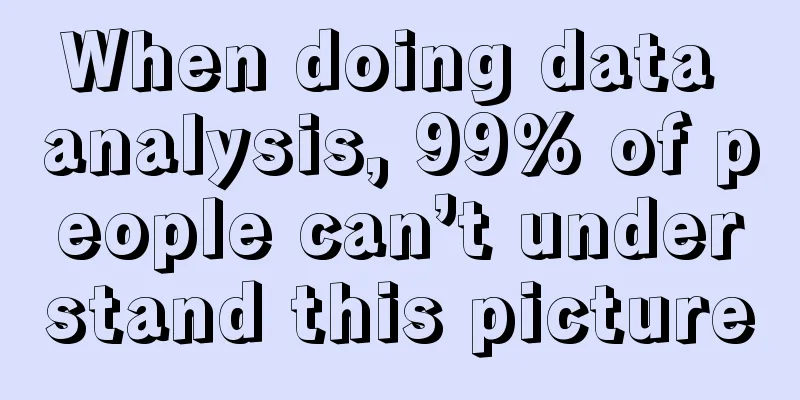When doing data analysis, 99% of people can’t understand this picture

Students often complain that in the company, they are always asked: What do you see from the data? But the actual data is just a few curves, and they don’t know how to interpret it. No one teaches them. After they finally write a few sentences, they are rejected: "You are just talking nonsense, we need deeper meaning." What should I do? Let’s take the simplest example. Below is the sales data of a company for one week. What do you see? 1. Examples of incorrect data interpretation
2. The key to interpretation is to clarify the business meaningThe common point of the above three mistakes is: just talking about numbers and stopping at data. Not reading the business meaning behind the data. In fact, data interpretation is not difficult at all. We use it every day every month, for example: The same is true for business departments making decisions. What they want to hear is: not cost-effective, don’t like, can’t afford. What they want to hear more is: “Today’s lunch budget is only 50 yuan per person, this Sichuan restaurant is both full and delicious”. What they want to hear is definitely not “There are 28 restaurants within 2 kilometers, the average price is 63 yuan, the highest price is 725 yuan, the lowest price is 13 yuan, and the price has increased by 10% compared with last month” - this is really meaningless. To make this judgment, three conditions are required:
For example, the average cost per person in a restaurant on Dianping is 185 yuan. It is not an isolated number, but the cost of filling a stomach, which is the real meaning of the average cost per person. If the cost is low, it is acceptable, but if it is high, it is unaffordable. This is the real difference between data size. For example, my monthly meal budget is only 3,000 yuan, which means I only have 100 yuan a day, so there is a standard. If this meal costs 185, I will have to eat dirt tomorrow. This forms a judgment: it is too expensive, I have to go to another place. The same is true for interpreting corporate data. You cannot just look at the data and ignore the business. The same three points:
Let’s look at them one by one below. 3. Start by understanding the business implicationsGoing back to the example at the beginning, the indicator "sales performance" itself has many meanings.
But please note: there is no standard here, so it is impossible to judge whether it is good or bad. This is why it is a very wrong behavior to directly conclude that if the performance is low, you should improve it. Sales performance directly reflects the efforts of the sales team. If we want to know whether this value is good or bad, we can directly ask "How many KPIs have the sales team achieved?"; we can also judge from the performance curve trend. This requires the second step: observing the performance trend. 4. Observe the performance trendA question: "What kind of product will sell like this?" Because there are seven days of data, it may represent three trends: 1. Natural cyclical changesSeven days represent a week. Monday to Friday are working days, and Saturday and Sunday are rest days. So this is a product that sells more on working days and no sales on rest days. Yes, you naturally think that this may be a B2B transaction. There is a lot of business on working days, and Sundays are rest days. Or it may be a derivative business around B2B, such as restaurants in CBD. 2. Life cycle changesIt is possible that a flagship product has reached the end of its life cycle and is being withdrawn from the market. A new product is about to be launched, which is a temporary change. Note that when looking at life cycle data, we usually look at the T+N day chart from the beginning of the life cycle, not the natural day chart. 3. Sudden changesIt is possible that there was a problem on Saturday and the trading system was down, it is possible that the promotion ended on Saturday and Sunday, or it is possible that there was bad weather on Saturday and Sunday. By judging the trend, we can establish a preliminary standard. If it is a cyclical change, it is likely to be a normal fluctuation, and we can initially judge it as "normal". If it is a sudden drop, it is likely to be an abnormal and bad fluctuation, and we can initially judge it as "problematic". With the standard, we can make a judgment, but all three assumptions are possible and need further verification. 5. List hypotheses for verificationIf you want to know whether your thinking is correct, you have to verify the hypothesis. There are two ways to verify the hypothesis: first, you can communicate with the business department to understand the actual situation. Second, you can refer to past data to verify your judgment and reversely verify whether the business department is lying. Data validation can be very complex, but it can also be very simple. It does not require complex logic, just a curve is enough. See the figure below. As long as the time is extended, the reasons for the change can be interpreted by relying on the performance trend + business performance. If there have always been cyclical fluctuations in the past, the cyclical pattern can be seen by extending the time. In actual business operations, the above three situations often occur, but in more complex forms, often a mixture of the three. For example, B2C retail and B2B sales are opposite:
When looking at data, we often put labels on the performance curve, such as whether a date is a holiday, whether a key product has reached the end of its life cycle, or whether there is an emergency. In this way, we can distinguish patterns from seemingly irregular curves. This is why many experienced business personnel can quickly judge the situation even without specialized data analysis. This is because they know what happened in the business and the past performance curve. Looking at the trend in combination with business performance is much more useful than blindly calculating year-on-year, month-on-month, average, and median. 6. Look into the detailsThe previous step only helped everyone understand the meaning of the data, but did not answer any questions. If you stop at the previous step, you will become a yes-man for the business: "The decline in performance is due to heavy rain" or "This is a normal fluctuation, and it will definitely fall over the weekend"... If you simply interpret it this way, you are likely to be met with a reply: "I knew it a long time ago." In fact, people often pay attention to sudden acute diseases, but often fail to pay attention to chronic diseases. For example, the following picture: If you only look at the daily data, you will feel that there is not much fluctuation every day, and you can only feel that the beginning of the month is slightly higher than the end of the month. But if you look at the weekly data, you will find a problem. Why is there no sprint for performance in the last week of the month with good performance? Last month's performance was good + no sprint at the end of the month + this month's start was particularly good. This curve trend is not regular, and it is very likely that this is the "hiding performance" behavior in B2B sales. At this time, the data analysts can also tell the front-line business: I knew it a long time ago. They can even infer how much performance each of them has hidden based on how many orders they have issued at the beginning of next month. This is why in actual business operations, we don’t just look at a single number, but build a data indicator system and do daily, weekly, and monthly reports. Daily reports are used to link business actions and respond to sudden problems, while weekly and monthly reports are used to track trends and discover deeper problems. Deeper problems are then solved through special topic analysis. This constitutes a data analysis system, and systematic operations are powerful. Of course, the actual analysis scenario will be more complicated. It is possible that after interpreting the data, we will come to the conclusion that "sales are hiding orders, and the actual performance is better than what the data reflects." However, whether it is hidden or not, and how much is the real amount, we still need to set up a special project and conduct in-depth analysis. But in any case, we have made a lot of progress compared to just replying with one sentence: "We need to raise it!", and we can also win the respect of the business. 7. Interpreting data is a hard skillSome students may ask: Since it is so difficult to let data analysts guess, why not communicate the business needs directly? Yes, in theory, the best state is that there is regular communication between business and data, with the business stating the needs and the data providing the conclusions. However, this state does not exist in most companies. In most companies, everyone is busy with their own business. Data is busy crawling tables and outputting data to deal with various daily reports, and business is busy working and fighting. There are deep trenches and high barriers between departments, and there is almost no communication. The larger the company, the more this is the case. In addition, many people do not have a clear understanding of data analysis itself, and still have the impression that "a Taoist priest with a fairy-like appearance can calculate with his fingers and speak out shocking words." This has led to the problem at the beginning of the article. Therefore, data analysts cannot simply expect the business to sort out all the problems and throw them to them, but must have the ability to actively interpret them. Author: Down-to-earth Teacher Chen WeChat public account: Down-to-earth Teacher Chen (ID: gh_abf29df6ada8) |
<<: How to get accurate leads through content (Part 2)
>>: With more short videos, will Xiaohongshu become “TikTok-like”?
Recommend
What are the operating skills of Alibaba International Station? How to do it well?
Now many businesses are doing Alibaba Internationa...
Entering the Red Ocean, How Should Video Authors Choose a Platform?
When making videos, every video creator has to fac...
Damn! Why are these brands better at choosing targets than I am! | Monthly Case
In 2023, there was a wave of co-branding, and co-b...
How can a WeChat public account have a chance to be recommended by the system?
This article will unveil the WeChat official accou...
Learn to be a "stall owner" on Xiaohongshu, and your ideas for monetization will open up immediately
Xiaohongshu has multiple monetization methods, adv...
Is Wishgo an independent cooperative site of Wish? Is Wishgo a subsidiary of Wish?
In the e-commerce field, Wish is a popular shoppin...
How to do SEO optimization for independent websites? Independent website optimization guide
More and more people want to enter the independent...
What does Wish distribution mean? How does Wish distribute products?
Wish is one of the cross-border e-commerce platfor...
How does shein ship? Platform shipping rules
When it comes to SHEIN's delivery process, one...
How to authenticate eBay videos? What should I do if eBay's cross-border authentication fails?
In the wave of Internet transactions, eBay, as a w...
How to make operations more efficient?
Operational work is numerous and complex, requirin...
Customer experience: Pinduoduo “only refunds” and is playing a high-end game theory game!
When implementing a "refund only" policy...
The 146th day of Hema’s “turning over the table”
Hema has been plagued by negative news recently. F...
There are so many outdoor UP hosts, why is Xu Yun the only one who has become the top streamer on Bilibili?
This article focuses on Xu Yun, a top outdoor UP h...
DHgate.com launches new store membership system
Enabling every customer to place one more order is...









